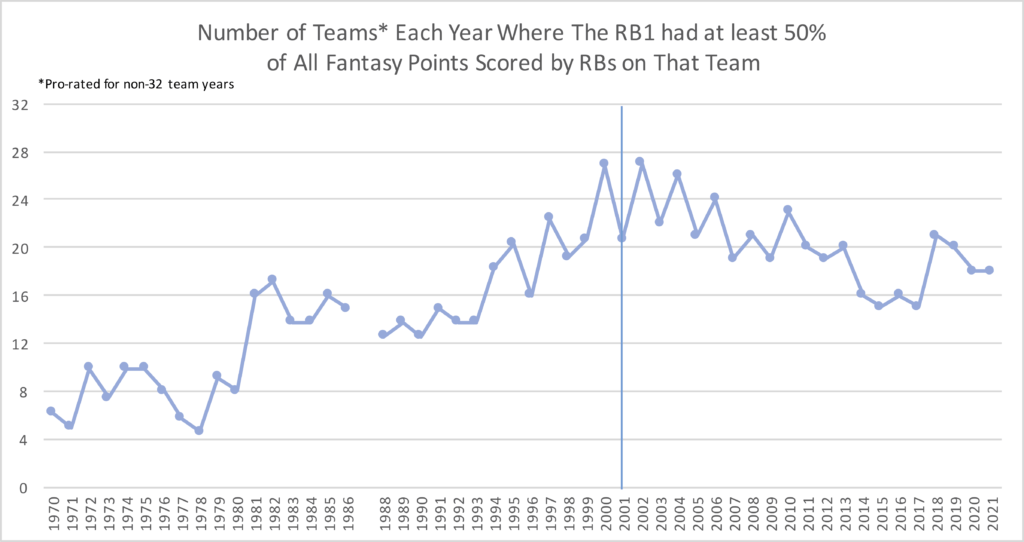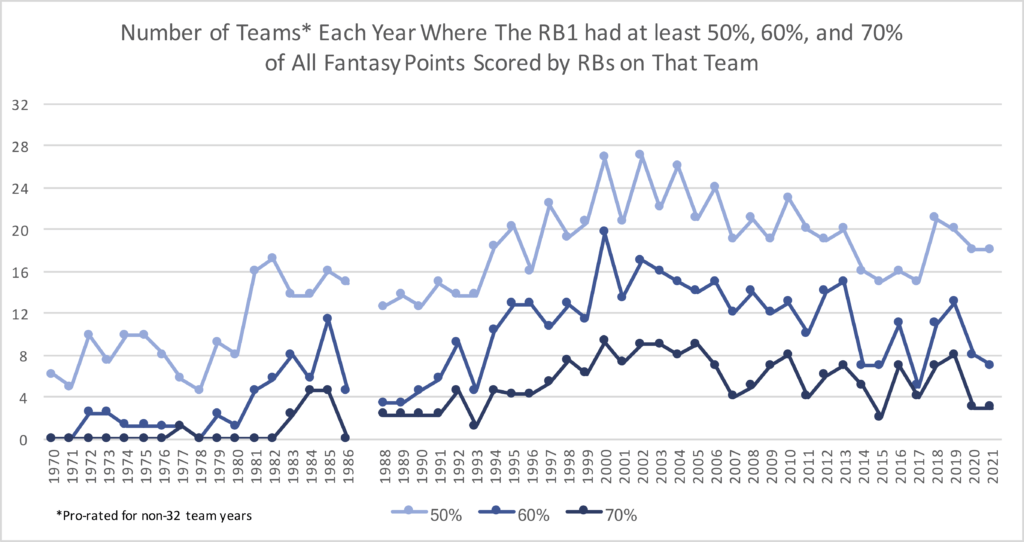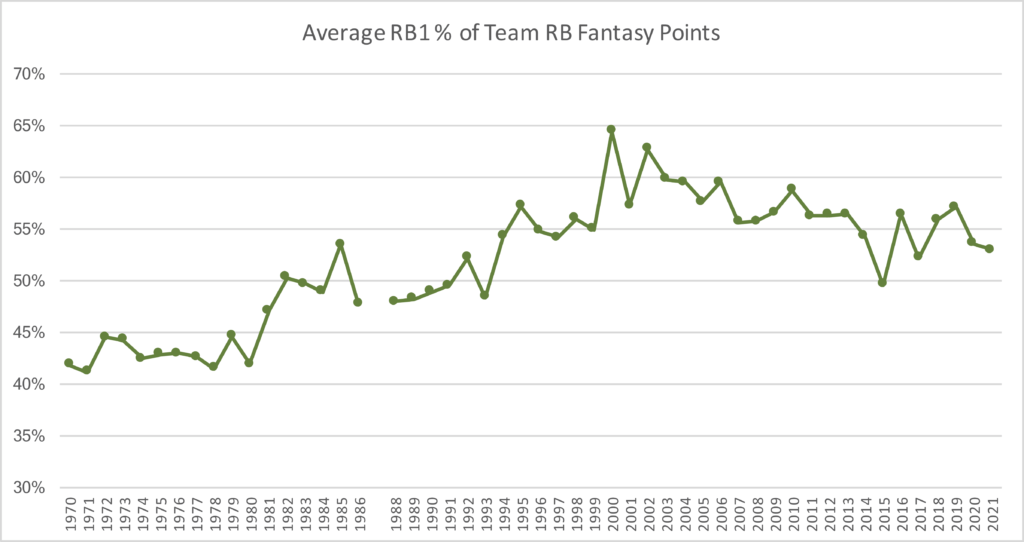Twenty years ago, in the summer of 2002, Doug Drinen wrote this about Running Back By Committee:
Any way you want to look at it, the use of RBBC has been decreasing for about three decades. In 2000, RBBC was at an all-time (since 1970) low. In 2001, it was back up slightly, but was still lower than it has ever been.
Drinen labeled a running back by committee (RBBC) if the team’s top running back scored less than half of the team’s total fantasy points by running backs. How do things look over the last 20 years? [1]In my effort re-create Drinen’s study, I am defining fantasy points as (receptions / 2) + (rushing yards + receiving yards) / 10 + (rushing TDs + receiving TDs ) * 6.
The graph below shows how many teams did not have a RBBC — i.e., it shows how many teams saw their RB1 have at least half of their team’s total fantasy points by running backs. [2]I have pro-rated the years before 2002 as if there were still 32 teams, to make for a more appropriate visual comparison. By way of example, in 2002, for 27 of the league’s 32 teams, the top RB on that team scored at least 50% of his team’s fantasy points scored by all running backs. In 2021, that number was just 18, while in 1980, that number was only 8. [3]Well, technically 7 out of 28 teams, or a pro-rated 8 teams in a 32-team season. And the 1987 replacement player-tainted season has been removed.
I included a line to show the 2001 season, after which Drinen wrote his article. As he noted, he was writing during the high-water mark of the stud RB era: as of the early 2000s, RBBC was significantly on the decline!

Since then? It’s a bit more complicated. Teams are relying less frequently on one running back compared to the early ’00s, but leaning on one player is still relatively common. From 1970 to 1993, only one season saw more than half of the teams in the NFL not have a RBBC. And that season was 1982, itself a strike-shortened year! Two other years — ’81 and ’85 — saw exactly half the league have a RBBC, making the early part of the ’80s was a the high point from ’70 to ’93. But starting in 1994, [4]Perhaps related to free agency? teams really began to lean on just one running back. That peaked in the five-year period from ’00 to ’04, which was a truly wild time for fantasy football and the height of the “Stud RB” era.
Consider that from ’00 to ’04, Ahman Green averaged 1,995 yards from scrimmage per 17 games, a number that only one player (Jonathan Taylor) hit in 2021. And he did it while averaging 4.7 yards per carry! And Green, while a very good player, was not a Hall of Fame running back or all that close to being one despite these crazy numbers. Tiki Barber produced five seasons that, after adjusting for age are among the more incredible feats in running back history. He also is not a Hall of Famer. [5]The discussion of whether we should be adjusting for “inflation” when analyzing these running backs is an interesting one left for another day.
I also ran the same study but used 60% and 70% cut-offs instead of just the 50% number. This really shows which teams are relying heavily on just one runner. Here’s that graph:

In general, the results are pretty similar. There is a slow rise and a peak in the early ’00s, followed by a smaller decline. At the 70% cut-off, there is an even smaller decline. I think it’s fair to say that by any metric, RBBC was very common in the ’70s and in general before 1995; it nearly disappeared in the late ’90s and early ’00s, and is currently in between those two levels.
Here’s another way to measure how much teams rely on one running back. Note that in 2021, Steelers rookie Najee Harris produced 92% of all fantasy points scored by Pittsburgh running backs. [6]Jonathan Taylor, who easily led all running backs in fantasy points, “only” scored 75% of all Colts running back points, as Nyheim Hines still picked up 586 scrimmage yards. Across the state, Eagles Kenneth Gainwell (106.9 fantasy points) pulled ahead of starter Miles Sanders (104.2 fantasy points) in week 17 to lead all Phialdelphia running backs in fantasy points. Gainwell scored 29% of all fantasy points scored by Eagles RBs, Sanders 28%, Boston Scott 25%, and Jordan Howard 16% (in just 7 games). So the Steelers RB1 scored 92% of all Pittsburgh RB fantasy points while the Eagles RB1 scored just 29% of all Philadelphia RB fantasy points. Across the 32 teams, the average RB1 scored 53% of his team’s fantasy points.
I decided to also calculate that number for each season since 1970. This might be my favorite way to measure the rise and (smaller) fall of the stud RB era in the NFL since the merger. [7]Or, from the perspective of RBBC fans, the fall and (smaller) rise of RBBC.

During the 1970s, the average NFL team saw its top running back produce just 43% of all fantasy points scored by that team’s running backs. It was a true committee just about everywhere. [8]Consider 1973, when O.J. Simpson rushed for 2,003 yards. He still only scored 63% of all fantasy points from Bills running backs that year. Perhaps more remarkably, consider that Simpson only … Continue reading That continued in 1980, but 1981 saw an enormous change: that year, RB1s across the NFL produced 47% of their team’s fantasy points from running backs, easily setting a record in the post-merger era. And it’s been higher than that mark every year since! From ’82 to ’86, the average was exactly at 50%, and was right around 50% for most of ’88 to ’93. Then, in 1994, that number jumped to 54% and stayed in the mid-50s until an outlandish 64% was hit in 2000. After a slight dip in ’01, the 60% mark was once again crossed for the second, and final time, in 2002.
The league then saw a steady increase in RBBC and decrease in RB1 percentage that resulted in a 2015 season where RB1 production dropped below 50% for the first time since 1993! That does appear to be an outlier, though, and since then, RB1 has been right around 54-55%. There are still a few teams — the Titans, Steelers, Panthers, and the rare team with a superstar RB — that operate as though it was still 2002. But most teams are now operating in a sort of gray zone between the old committee approach from the ’70s and the stud RB times of two decades ago.
References
| ↑1 | In my effort re-create Drinen’s study, I am defining fantasy points as (receptions / 2) + (rushing yards + receiving yards) / 10 + (rushing TDs + receiving TDs ) * 6. |
|---|---|
| ↑2 | I have pro-rated the years before 2002 as if there were still 32 teams, to make for a more appropriate visual comparison. |
| ↑3 | Well, technically 7 out of 28 teams, or a pro-rated 8 teams in a 32-team season. And the 1987 replacement player-tainted season has been removed. |
| ↑4 | Perhaps related to free agency? |
| ↑5 | The discussion of whether we should be adjusting for “inflation” when analyzing these running backs is an interesting one left for another day. |
| ↑6 | Jonathan Taylor, who easily led all running backs in fantasy points, “only” scored 75% of all Colts running back points, as Nyheim Hines still picked up 586 scrimmage yards. |
| ↑7 | Or, from the perspective of RBBC fans, the fall and (smaller) rise of RBBC. |
| ↑8 | Consider 1973, when O.J. Simpson rushed for 2,003 yards. He still only scored 63% of all fantasy points from Bills running backs that year. Perhaps more remarkably, consider that Simpson only received 61% of all carries by Buffalo running backs. |
